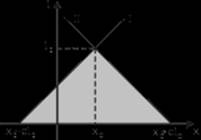University Mathematics Handbook (2015)
XIV. Partial Differential Equations (PDE)
Chapter 5. One-Dimensional Wave Equation
![]() (*)
(*)
when ![]() is the velocity of wave propagation.
is the velocity of wave propagation.
If ![]() , then it is a homogeneous equations.
, then it is a homogeneous equations.
5.1 General Solution of Homogeneous Equation ![]()
a. ![]() ,
, ![]() are characteristic lines.
are characteristic lines.
b. By change of variables ![]() ,
, ![]() we get the canonical form of a wave equation
we get the canonical form of a wave equation ![]() . Its solution is
. Its solution is ![]() , when functions
, when functions ![]() are arbitrary, continuous, and have partial derivatives continuous up to second order.
are arbitrary, continuous, and have partial derivatives continuous up to second order.
c. ![]() is a general solution of (*).
is a general solution of (*).
d. ![]() describes a (rightwards) forward wave at speed
describes a (rightwards) forward wave at speed ![]() .
.
![]() describes a (leftwards) backward wave at speed
describes a (leftwards) backward wave at speed ![]() .
.
General solution ![]() is a superposition of an forward wave and a backward wave with speed
is a superposition of an forward wave and a backward wave with speed ![]() .
.
5.2 Vibrations of an Infinite String. D'Alembert's
Formula
a. Equations system
![]() (*)
(*)
![]() (**)
(**)
describes the amplitude of an (ideal) elastic infinite string vibration. Initial conditions ![]() and
and ![]() are given functions describing amplitude
are given functions describing amplitude ![]() and vibration velocity
and vibration velocity ![]() at time
at time ![]() .
.
b. (*),(**) is called a Cauchy problem.
c. If ![]() and
and ![]() , then Cauchy problem (*),(**) has unique solution
, then Cauchy problem (*),(**) has unique solution ![]() given by D'Alembert's formula
given by D'Alembert's formula
![]() (***)
(***)
d. If ![]() is continuous,
is continuous, ![]() ,
, ![]() are piecewise continuous, and
are piecewise continuous, and ![]() and/or
and/or ![]() , then there are points where the first and second order derivatives of
, then there are points where the first and second order derivatives of ![]() do not necessarily exist, and therefore, function
do not necessarily exist, and therefore, function ![]() given by (**) is not a solution of problem/ (*), (**).
given by (**) is not a solution of problem/ (*), (**).
In any point except these ones, ![]() is a solution of the wave problem. In this case, we construct a generalized solution of the wave problem, the following way:
is a solution of the wave problem. In this case, we construct a generalized solution of the wave problem, the following way:
Choose two sequences ![]() ,
, ![]() , when
, when ![]() ,
, ![]() , uniformly converging to
, uniformly converging to ![]() and
and ![]() , respectively, in
, respectively, in ![]() .
.
Let the sequence ![]() be a solution of (*) holding.
be a solution of (*) holding.
![]()
Then, the sequence ![]() uniformly converges to the generalized solution,
uniformly converges to the generalized solution, ![]() .
.
5.3 Non-Homogeneous Wave Equation
a. The equations system
![]() (*)
(*)
![]() (**)
(**)
describes a vibration of an infinite string constrained by an external force ![]() . String amplitude
. String amplitude ![]() is dependent of initial conditions
is dependent of initial conditions ![]() and initial velocity
and initial velocity ![]() at time
at time ![]() .
.
b. The characteristic triangle ![]()
Through point ![]() , we draw 2 characteristic lines:
, we draw 2 characteristic lines:
![]() ,
, ![]()
forming, together with the ![]() -axis, a characteristic triangle (see illustration).
-axis, a characteristic triangle (see illustration).

c. If, in (**),![]() and
and ![]() , then, the solution of (*) is
, then, the solution of (*) is
![]()
d. If ![]() ,
, ![]() and functions
and functions ![]() and
and ![]() are continuous on
are continuous on ![]() ,
, ![]() , then the unique solution of Cauchy problem (*),(**) is
, then the unique solution of Cauchy problem (*),(**) is
![]()
5.4 Vibrations of Semi-Infinite String
a. Homogeneous cauchy problem:
![]() (*)
(*)
Initial condition:
![]() (**)
(**)
Boundary condition:
![]() (***)
(***)
The solution is

b. The solutions of non-homogeneous problem
![]()
with the same initial condition (**) or boundary condition (***) are ![]()
when ![]() is the solution of homogeneous problem (see a.) and
is the solution of homogeneous problem (see a.) and

c. If, in a Cauchy problem, the boundary condition is non-homogeneous, that is, (***) is replaced by ![]() , then, by substituting
, then, by substituting ![]() , we get the non-homogeneous problem
, we get the non-homogeneous problem
![]()
![]()
5.5 Vibrationof a Finite String (Both Ends Fixed)
The finite string wave equation is
![]()
Initial condition is: ![]()
Boundary condition is: ![]()
To use D'Alembert’s formula (see 5.3), we extend functions ![]() ,
, ![]() ,
, ![]() on all
on all ![]() -axis, through interval ends
-axis, through interval ends ![]() and
and ![]() , to odd and periodic functions with a
, to odd and periodic functions with a ![]() period, that is
period, that is
![]()
Similarly, we construct functions ![]() and
and ![]() .
.
Using the D'Alembert’s formula mentioned in 5.3 to find the solution of the problem.
The reduction of this solution to ![]() ,
, ![]() is the solution of the given problem.
is the solution of the given problem.
If, in addition, ![]() satisfy the compatibility condition
satisfy the compatibility condition
![]()
and ![]() , then Cauchy problem has a unique solution
, then Cauchy problem has a unique solution ![]() .
.